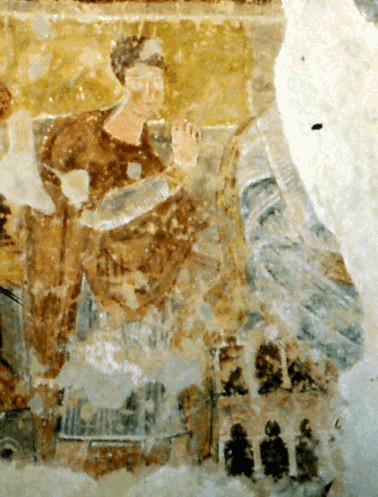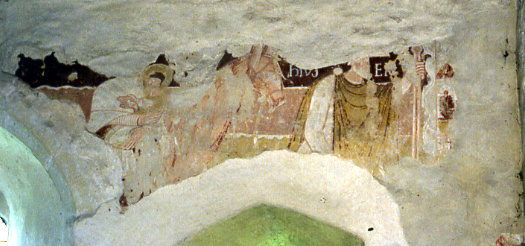Coombes, West Sussex (†Chichester) C.12
King Herod and attendants, and the Flight into Egypt

The paintings remaining in the church at Coombes provide a good illustration of the general difficulties involved in recognising, identifying, and commenting on this kind of medieval art. Sometime in the later 12th century the small church was fully painted with a coherent and unified scheme including a Maestà or Christ in Majesty over the chancel arch. The scheme would have been comparable in scope, style and indeed quality to other 12th century painted schemes in Sussex such as those at Clayton, Hardham and West Chiltington, also in Sussex. The problem is that only a few scenes, all in various states of dilapidation, remain, making useful comment on them problematic.
Here to begin with though are three scenes, the first two of them (photo, left) unique. They are part of the story of the journey of the Magi to Bethlehem, and show the incident narrated in Matthew, chapter 2 where having heard that wise men from the east had been enquiring in Jerusalem about the birth of a new King of the Jews, King Herod asked his advisors for more information about this long-prophesied event. The figure on the left (photo, left) is one of the advisors, and he is painted in an attitude indicating speech, although his long extended right index finger is hard to see now. Herod is seated at the right, and all that remains of him is his voluminously-billowing white and grey sleeve and the arm of his golden throne, but enough remains, I think, to convey the required sense of overweening authority.

Thus far, the incident is Biblical, but the painter has embellished the story by including at this point a scene (photo, left) illustrating the doubts about parentage that Mary’s pregnancy provoked. The source for this may have been the account of the Nativity in the Pseudo-Matthew, but even the canonical Gospel of Matthew hints at the atmosphere of suspicion surrounding Mary, who in the circumstances might well have found herself made a ‘publick example’ (Matthew 1:19). At Coombes, on the south wall, are three figures, their headgear, like that of Herod’s interlocutor above, identifying them as Jews. Two of the figures stand, hands raised to signify surprise or suspicion, while a third at the furthest right is painted in an attitude of cautious stealth about to pull aside a curtain. What was beyond has gone, but it was probably a Nativity scene, or perhaps a depiction of ‘Joseph’s Doubts’¹ and the angelic reassurance he received (Matthew 1, 19-25).

The next event in the Nativity story is also painted on the south wall of the nave; it must have been beautiful once, and it is eloquent even in its present damaged state. Joseph, leaning on his staff, leads at the right, with Mary and the infant Jesus following on a donkey. It is hard to be sure whether the now-fragmentary and unreadable inscription on the wall behind has anything to do with this scene or not, but, like the narrative scenes here, it is high-class work.
There are other early paintings at Coombes – a fragment of what was probably an Annunciation and the faded remains of the Christ in Majesty mentioned above. Also newly on the site are a Traditio Legis similar to that at Clayton, and a remarkable illusionistic painted figure on the soffit of the chancel arch. There are more fragments from later periods too, and fairly extensive areas of purely decorative work.
¹ For obvious reasons these ‘doubts’ are better acted out than painted, and later, in the Mystery Plays, they were, as in for example the Pewterers’ and Founders’ play, The York Cycle of Mystery Plays, ed. JS Purvis, 1957, p.86ff.